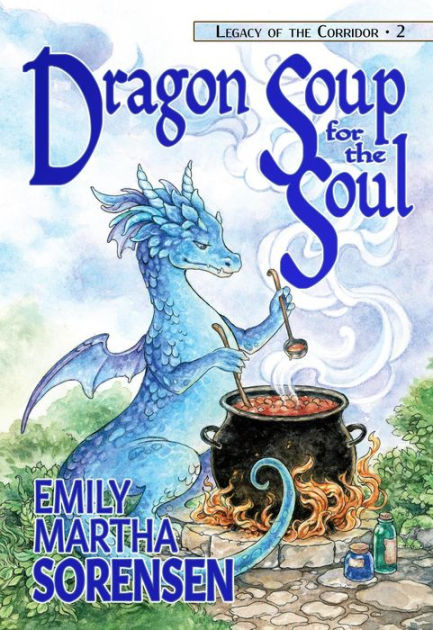
Review
======
Title: Dragon Soup for the Soul
Author: Emily Martha Sorensen
Publisher: Hemelein Publications
Genre: Fantasy, short story collection
Year Published: 2021
Number of Pages: 341
Binding: Paper
ISBN: 978-1642780161
Price: 17.99
Reviewed by Adam McLain for the Association for Mormon Letters
On the back copy of Emily Martha Sorensen’s Dragon Soup for the Soul, the second in the Legacy of the Corridor series from Hemelein Publications, the reader is directed to “pull up your coziest blanket and favorite warm drink and enjoy these fantastical tales.” The idea of cozy fantasy is repeated through the editorial note by series editor Joe Monson, and I want to repeat that idea here too. The stories collected in Sorensen’s text are cozy, comfortable, and delightful. Rather than the epic nature of fantasy that the Corridor (the geographic area of the Rocky Mountains from which the series pulls its authors) is becoming known for, Sorensen’s works are quieter and tamer, and within that mood and setting, Sorensen brings out the heart and nature of human relationships and plays with the ideas of narrative, story, and character in ways that simultaneously reinforce and break cliches. Whether newlyweds are stressed out over the care of their just-hatched dragon baby or teenage princesses are bucking the demands of their queenly mother and marrying the wrong men, Sorensen’s many tales celebrate, enjoy, and herald the many good things that exist in worlds both real and fantastical.
Dragon Soup for the Soul is loosely divided into four sections. The first section is a myriad of short stories and narrative poems from disparate and diverse universes. From a dragon almost eating Rudolph (yes, the red-nosed reindeer Rudolph) and subsequently meeting Santa to an ogre cursed to be a cat, Sorensen exhibits her knack for witty charm and playing with expectations as she rewrites fairy tale tropes and creates a few of her own along the way. The next section is a large excerpt—containing two short novels and two much shorter short stories—from Sorensen’s Dragon Eggs series, a narrative set in a 1920s world that has dragons hatching after they’ve been extinct for many years. The third section returns to the myriad of stories, pulling from many of Sorensen’s already-established worlds and bringing them into smaller pieces—snapshots, really, of much larger works. The final section is a complete trilogy of short novels—the Virgo Curse trilogy.
The collection is a menagerie introduction to Sorensen’s work rather than stories written on a theme. Most of the works are republished or expanded from previous shorter works, and the reader sometimes becomes lost in the plethora of worlds Sorensen’s stories inhabit. As an introduction to Sorensen’s work, then, this book works well in its diversity; I walked away from my reading thinking about Sorensen’s penchant for personal and individual stakes and her use of humor in the mundane. As a collection, it lacks cohesiveness and connection, providing no through-point except to highlight the author’s works. This is not necessarily a bad thing; rather, it is mostly an authorial and editorial decision. I would have liked a little more cohesiveness between the stories or at least more robust introductions, which could’ve come from expanded authorial notes. I found many of the postscript author notes were written to an assumed reader who is familiar with Sorensen; a reader picking this text from the shelf and having never read Sorensen, like myself, might be confused, for example, when Sorensen briefly mentions in her short story about queer acceptance that “there is room in Zion for a system like this” if they have no knowledge of Mormonism, or when Sorensen cites her numerous other texts without introducing them (as she does in the finale collections of tales from the Dragon Eggs universe and Virgo Curse trilogy, discussing the other books without explaining what they are about).
Even though I wanted more introduction and explanation throughout the collection, this fault does not bely Sorensen’s ability to instantly relate reader to character, bringing readers into a new world and making it seem familiar—an ability seen through each and every story. For example, in “Third Princess,” a short story about romances gone wrong (at least, to a scheming mother), Sorensen begins the story with the following paragraphs:
“Send in my eldest daughter,” the Queen ordered. “Penelope.”
The butler cleared his throat. “Ah … your majesty, your eldest daughter’s name is Prunella.”
“Whichever.” The Queen waved an imperious hand. “The eldest.”
The reader is immediately brought into the folds of the story and realizes some of the key character traits on which the plot relies: a queen bereft of her daughters’ identities who wants to just use them as pawns; a butler who is subservient yet trusted enough to correct the queen; and a plot that centers around these unknown-to-their-mother princesses. With Sorensen’s many texts, readers don’t need to take the time to discover the world; the world is presented in a way that envelopes the senses and pulls the reader through to the end. This writing technique makes this collection of stories easily digestible yet still something to chew upon to nourish the soul.
Just as the series the title of the collection pays homage to (Chicken Soup for the Soul), Dragon Soup for the Soul gives readers comfort stories written by a master weaver of benign optimism and humorous appeal. If one is downtrodden with the world or wants some dragons without the carnage and gore, look no further than Emily Martha Sorensen.
